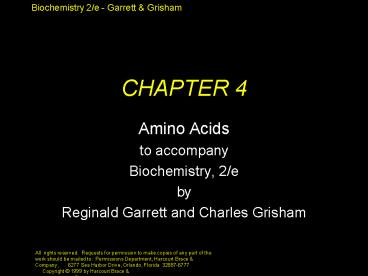Amino Acids - PowerPoint PPT Presentation
1 / 42
Title:
Amino Acids
Description:
Requests for permission to make copies of any part of the work should be mailed to: Permissions Department, Harcourt Brace & Company, 6277 Sea Harbor Drive, Orlando ... – PowerPoint PPT presentation
Number of Views:25
Avg rating:3.0/5.0
Title: Amino Acids
1
CHAPTER 4
- Amino Acids
- to accompany
- Biochemistry, 2/e
- by
- Reginald Garrett and Charles Grisham
All rights reserved. Requests for permission to
make copies of any part of the work should be
mailed to Permissions Department, Harcourt
Brace Company, 6277 Sea Harbor Drive,
Orlando, Florida 32887-6777
2
Outline
- 4.1 Amino Acids Building Blocks of Proteins
- 4.2 Acid-Base Chemistry of Amino Acids
- 4.3 Reactions of Amino Acids
- 4.4 Optical Activity and Stereochemistry of
Amino Acids - 4.5 Spectroscopic Properties of Amino Acids
- 4.6 Separation and Analysis of a.a. Mixtures
3
Amino AcidsBuilding Blocks of Proteins
4
Amino Acids Can Join Via Peptide Bonds
5
20 Common Amino Acids
- You should know names, structures, pKa values,
3-letter and 1-letter codes - Non-polar amino acids
- Polar, uncharged amino acids
- Acidic amino acids
- Basic amino acids
6
(No Transcript)
7
(No Transcript)
8
(No Transcript)
9
(No Transcript)
10
Uncommon Amino Acids
- We'll see some of these in later chapters
- Hydroxylysine, hydroxyproline - collagen
- Carboxyglutamate - blood-clotting proteins
- Pyroglutamate - bacteriorhodopsin
- Phosphorylated amino acids - signaling device
11
(No Transcript)
12
(No Transcript)
13
4.2 Acid-Base Chemistry
- Amino Acids are Weak Polyprotic Acids
- H2A H2O ? HA0 H3O
- Ka1 HA0 H3O
- __________________________
H2A
14
4.2 Acid-Base Chemistry
- The second dissociation (the amino group in the
case of glycine) - HA0 H2O ? A H3O
- Ka2 A H3O
- _______________________
HA0
15
(No Transcript)
16
pKa Values of the Amino Acids
- You should know these numbers and know what they
mean! - Alpha carboxyl group - pKa 2
- Alpha amino group - pKa 9
- These numbers are approximate, but entirely
suitable for our purposes.
17
pKa Values of the Amino Acids
- You should know these numbers and know what they
mean - Arginine, Arg, R pKa(guanidino group) 12.5
- Aspartic Acid, Asp, D pKa 3.9
- Cysteine, Cys, C pKa 8.3
- Glutamic Acid, Glu, E pKa 4.3
- Histidine, His, H pKa 6.0
18
pKa Values of the Amino Acids
- You should know these numbers and know what they
mean - Lysine, Lys, K pKa 10.5
- Serine, Ser, S pKa 13
- Threonine, Thr, T pKa 13
- Tyrosine, Tyr, Y pKa 10.1
19
Titration of Glycine
20
Titration of Glutamic Acid
21
A Sample Calculation
- What is the pH of a glutamic acid solution if the
alpha carboxyl is 1/4 dissociated? - pH 2 log10 1
-
3 - pH 2 (-0.477)
- pH 1.523
22
Titration of Lysine
23
Another Sample Calculation
- What is the pH of a lysine solution if the side
chain amino group is 3/4 dissociated? - pH 10.5 log10 3
-
-
1 - pH 10.5 (0.477)
- pH 10.977 11.0
24
Reactions of Amino Acids
- Carboxyl groups form amides esters
- Amino groups form Schiff bases and amides
- Side chains show unique reactivities
- Cys residues can form disulfides and can be
easily alkylated - Few reactions are specific to a single kind of
side chain
25
(No Transcript)
26
(No Transcript)
27
(No Transcript)
28
Stereochemistry of Amino Acids
- All but glycine are chiral
- L-amino acids predominate in nature
- D,L-nomenclature is based on D- and
L-glyceraldehyde - R,S-nomenclature system is superior, since amino
acids like isoleucine and threonine (with two
chiral centers) can be named unambiguously
29
(No Transcript)
30
(No Transcript)
31
(No Transcript)
32
(No Transcript)
33
Spectroscopic Properties
- All amino acids absorb in infrared region
- Only Phe, Tyr, and Trp absorb UV
- Absorbance at 280 nm is a good diagnostic device
for amino acids - NMR spectra are characteristic of each residue in
a protein, and high resolution NMR measurements
can be used to elucidate three-dimensional
structures of proteins
34
(No Transcript)
35
(No Transcript)
36
(No Transcript)
37
Separation of Amino Acids
- Mikhail Tswett, a Russian botanist, first
separated colorful plant pigments by
chromatography - Many chromatographic methods exist for separation
of amino acid mixtures - Ion exchange chromatography
- High-performance liquid chromatography
38
(No Transcript)
39
(No Transcript)
40
(No Transcript)
41
(No Transcript)
42
(No Transcript)































